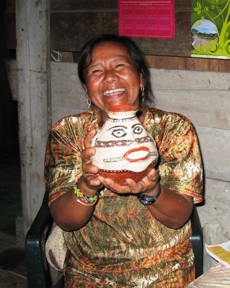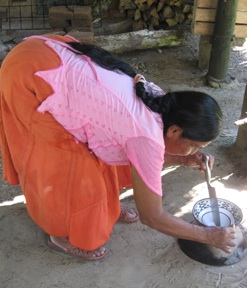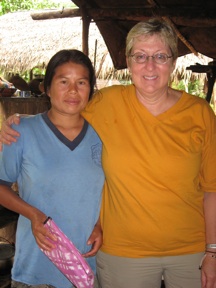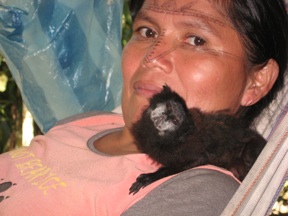All would be accurate and attention grabbing headlines for a blog post on our recent trip to Ecuador, but rather than focus on the tabloid sensational, I’m opting to introduce several women who are quietly sensational in their own way.
Rebecca is an 82-year old Kichwa woman from Sarayacu, in Pastaza Province. She has raised a large family whose members are at home in the rainforest or in town, hold government posts, and one daughter lives abroad. Along with a group of face-painted, spear-brandishing women, Rebecca once confronted soldiers and oil workers and escorted them to a meeting where the women explained to their captive audience the Kichwa’s connection to the land and that oil exploration violates their relationship with the forest. Rebecca is well respected as a potter who possesses not only technical skills, but also knows the significance and history of the intricate designs she creates. She is decidedly “old school”, having fired pieces individually over an open flame with ash heaped over it for nearly 70 years. Nonetheless, she willingly brought several mucawas to the workshop to try out the gas-fired kiln being constructed by Joe Molinaro and Jake Boggs. Despite Joe’s emphatic “Es un experimento” when the first one broke, it was clear she was thinking that the old ways were the best. Then, when the next mucawa came out of the kiln in one piece and she heard the musical “ping” that indicates a much more durable ware, her eyes lit up. Rebecca was ready to embrace another innovation.
 Esthela is a Kichwa woman living in Puyo, having left her jungle home many years ago. Esthela is a gatherer – of yucu when she had a garden, of clay and pigments for her pottery, and of children. She is raising her own children as well as various grandchildren whose parents’ lives have ended tragically and assorted nieces and pretty much anyone who needs a mother. Relationship lines aren’t always easy for me to follow, especially when a half dozen surnames identify most of the inhabitants of the area. Esthela’s home is a simple structure of wooden planks with a tin roof, accessed by a steep set of uneven stairs leading down from the street and an equally steep ramp leading up to her studio and home. Un-informed passersby might stop by her daughter Miriam’s street level gallery on one side or her daughter Marta’s new street level restaurant on the other, but are less likely to venture into Esthela’s realm. Joe has an impressive collection of Esthela’s pots and figures – and was given about a dozen more during our visit. He and I spent an enlightening afternoon with Esthela, reviewing images of her figures and completing information for a database he is keeping. I was reminded yet again of the imprecise art of interpretation and the challenge of resisting the temptation to mold circular thoughts and stories into linear concepts. And if you want to know about the figure whose penis grew and grew and grew and eventually became boa constrictors, ask Joe!
Esthela is a Kichwa woman living in Puyo, having left her jungle home many years ago. Esthela is a gatherer – of yucu when she had a garden, of clay and pigments for her pottery, and of children. She is raising her own children as well as various grandchildren whose parents’ lives have ended tragically and assorted nieces and pretty much anyone who needs a mother. Relationship lines aren’t always easy for me to follow, especially when a half dozen surnames identify most of the inhabitants of the area. Esthela’s home is a simple structure of wooden planks with a tin roof, accessed by a steep set of uneven stairs leading down from the street and an equally steep ramp leading up to her studio and home. Un-informed passersby might stop by her daughter Miriam’s street level gallery on one side or her daughter Marta’s new street level restaurant on the other, but are less likely to venture into Esthela’s realm. Joe has an impressive collection of Esthela’s pots and figures – and was given about a dozen more during our visit. He and I spent an enlightening afternoon with Esthela, reviewing images of her figures and completing information for a database he is keeping. I was reminded yet again of the imprecise art of interpretation and the challenge of resisting the temptation to mold circular thoughts and stories into linear concepts. And if you want to know about the figure whose penis grew and grew and grew and eventually became boa constrictors, ask Joe!
Gladys is my comadre and the wife of Cesar Gualinga. I met Cesar in 1993 when we were both working for Douglas McMeekin, but I did not meet Gladys until my first visit to Jatun Molino in 2004. Gladys is from Napo Province and met Cesar when he was working at Douglas’ Yachana Lodge in Mondana. She moved with him to Molino, and fifteen years and six children later, she has never returned to Napo to visit her family. Though it would only be a day’s journey, it is akin to early pioneers in the U.S. pulling up stakes, leaving their families, and going West. Gladys is shy, but did open up more to me on this, my third visit. Quietly competent is how I would best describe her. Her garden sustains a large extended family and she is forever cooking, washing clothes, serving chicha and nursing a baby. Ceramic making is not practiced much where she grew up, but she took it up when she moved to Molino She rarely has down time, but on Sunday afternoon she did sit with us while we watched Cesar make a fish trap and blew bubbles at the pet monkey. Come to think of it, she was still serving chicha, tending her as yet unnamed baby and keeping a close eye on 3-year old Charley as he cut palm leaves with a butcher knife. She told me that with this baby, labor did not progress and it was determined that the baby was breech. Cesar was not there and since there is no midwife in Molino, she was loaded into a canoe and taken a couple of hours upstream to Sarayacu where a midwife was able to turn the baby. Gladys probably does not consider herself extraordinary, but I do.
Linda has spent her entire life in Jatun Molino. She is best known as an accomplished potter and she can often be seen sitting on a low stool, forming or painstakingly painting a mucawa with a small brush made from a few strands of her own hair. Using a tiny stick and liquid from a huitoc seed, she also paints intricate designs on her face and our arms or faces. I learned the hard way that these temporary tattoos easily last three weeks, so after my first visit I limit them to my arms. Years before I met Linda, I got word through Joe that she had been bitten by a fer-de-lance, the deadliest snake in the rainforest. She had been evacuated to the hospital by missionary plane and her brothers were working in the hospital to pay her bill which meant they were not home hunting, fishing and caring for their families. Through Partners, we raised $1500 to pay off the bill. Until this trip, I had never seen Linda without her rubber boots on. From the knee down, Linda’s leg is a mass of scar tissue that looks to be the result of a terrible burn, but is actually the scarring from the extensive tissue damage of the snake bite. There is also a large hole in the top of her foot – the result of an earlier snake bite as a child. She walks with a distinct hitch in her gait. As if this burden weren’t enough, Linda’s husband fell ill and died suddenly a couple of years ago while preparing a garden site. She and her daughter live with Cesar, his wife and six children, and the grandmother. Linda’s constant companion is a small monkey that snuggles on her shoulder and peeps out from beneath her hair.
Even if this was my last trip to the Ecuadorian jungle, these women have made an impression that will last a lifetime.
Kay Roberts, Executive Director of Kentucky Ecuador Partners
Summer 2012



